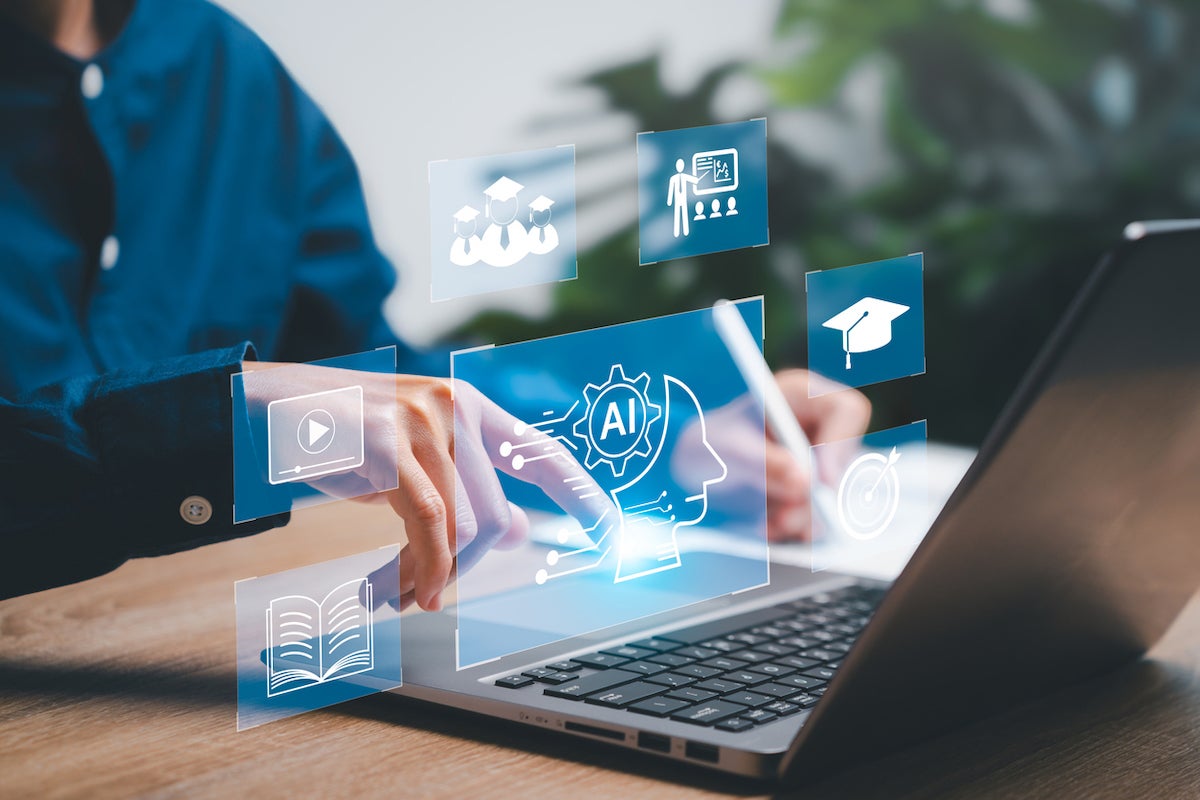Kristal Ayres ’92MEd remembers the day at UCF when an instructor told her to pull a pair of goggles over her eyes. This was 1991. Ayres was an elementary teacher working toward her master’s degree as a reading specialist. Goggles were used on ski slopes and in welding shops. Ayres wondered what good they could do in a classroom.

“The goggles were my introduction to technology within the education environment,” says Ayres, who is now the education leader for programs and AI at Google, “and they completely transformed my thinking.”
Ayres had enrolled in the master’s program at UCF so she could help the alarming number of high school students who were reading at an elementary school level. Teachers like her would try to watch each student read, paying attention to the ways their eyes tracked, whether they used a finger to follow printed words, and hoping not to miss a clue about dyslexia or any number of learning disorders. Ayres knew then what is truer than ever today: Something needs to change.
And the goggles opened her eyes to this revolutionary teachers’ aid called “technology.”
“I understand what teachers at all levels face on a daily basis,” she says. “We want to personalize learning, but it’s nearly impossible when you have dozens or hundreds of students. I remember with those goggles thinking, ‘Wow, something besides a human can help us assist students with reading difficulties.’”
Ayres tells the story from her remote home office in the hills of north Georgia. Her career path has led her from K-12 teaching environments to administrative roles to chief academic officer in 2014 with BrightBytes, the first educational company to identify students at risk of not making grade level progress through the use of localized predictive analytics — what we commonly call “artificial intelligence.” (Ayres brought her breadth of experiences to Google when the company acquired BrightBytes in 2022.)
Today, Ayres collaborates with global education leaders about AI, talking with professors who have researched AI for nearly 50 years, and listening to the gamut of perspectives from educators: the possibilities and the fears.
“I understand teachers’ concerns about AI because at heart I will always be a teacher,” Ayres says, “but the train has left the station. So, I want educators to understand the phenomenal impact AI can provide as a teaching assistant for grading, tutoring, automating daily tasks, and improving education.”
The marriage of AI and education goes back to the 1960s, and predictive analytics is now baked into everyday life, with voice to text, spelling and grammar suggestions, and streaming services and search engines telling us what we want to see before we know we want to see it.
But when ChatGPT officially launched in November 2022, followed by Google’s conversational chatbot named Bard two months later, it shook the attention of parents, teachers, and administrators. It’s one thing for AI to help us choose a movie or punctuation, but to write an entire essay under a student’s byline?
“Generative AI is new territory,” Ayres says, “because it allows new outputs that feel human-generated, and that’s caused angst with some educators.”
The fears she hears in her discussions typically boil down to three common themes: cheating, security and differences in learning opportunities. Ayres does not downplay any of the concerns, but she doesn’t see them as immovable red flags either.
“Data from research on student behavior shows there’s no more likelihood of cheating with AI than there is without it. The security issue is a work in progress, which is true of any digital tool that requires credentials, even email. The third fear, differences in education, is most significant to me. It’s the idea that generative AI systems, if not carefully designed, can perpetuate biases from their training data.”
“By acknowledging these concerns and working proactively to address them, we can ensure that AI is used in a way that’s ethical and truly enhances the learning experience for all students.”
That’s where much of Ayres’ attention has been from the time she studied at UCF. She says AI “if used correctly, will level the playing field among students.”
The word “possibility” is almost a misnomer when she talks about AI in education. It’s always “can” and “will.” Ayres has been in classrooms and front offices. She’s studied the research and this is what she and her collaborators see on our doorstep.
For teachers:
“First, AI will never replace educators. We will always need teachers and right now we’re facing a teacher shortage due to burnout. With AI programs, we can streamline workflows so teachers can be more productive in less time. They can use AI programs to help grade and annotate hundreds of assignments. They can creatively use AI to make schoolwork more relevant — have students edit AI-generated essays rather than the other way around. This will help improve work-life balance, and as AI helps us do that, then we will retain and recruit the best educators.”
For students:
“We’ve always been told to ‘meet each student where they are.’ But how can educators avoid a cookie-cutter approach when they have so many students? With AI, we can assess each student and individualize lessons based on whether that student is artistically minded, tech-minded, or something else. Students can also access AI for real-time tutoring for subjects like math, where the tutor can pinpoint mistakes as they happen. The tutoring will be available regardless of financial means. This is the kind of personalized learning that’s been nearly impossible for teachers to create and administer on their own. Now, with AI, we can give students and teachers the help they need to thrive.”
There does appear to be one impossibility with AI in education: enumerating every benefit. And so, each time a question about AI comes her way, Ayres’ eyes open wider and brighter, as if she’s looking into those goggles for the first time.
“I’m super excited about the potential of AI to transform the educational landscape.”
Ayres had her “Aha!” moment 33 years ago. And now she wants everyone in education — teachers, students and parents — to have their moment, too.




